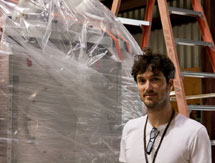
Handy Links
SLAC News Center
SLAC Today
- Subscribe
- Archives: Feb 2006-May 20, 2011
- Archives: May 23, 2011 and later
- Submit Feedback or Story Ideas
- About SLAC Today
SLAC News
Lab News
- Interactions
- Lightsources.org
- ILC NewsLine
- Int'l Science Grid This Week
- Fermilab Today
- Berkeley Lab News
- @brookhaven TODAY
- DOE Pulse
- CERN Courier
- DESY inForm
- US / LHC
SLAC Links
- Emergency
- Safety
- Policy Repository
- Site Entry Form

- Site Maps
- M & O Review
- Computing Status & Calendar
- SLAC Colloquium
- SLACspeak
- SLACspace
- SLAC Logo
- Café Menu
- Flea Market
- Web E-mail
- Marguerite Shuttle
- Discount Commuter Passes
-
Award Reporting Form
- SPIRES
- SciDoc
- Activity Groups
- Library
Stanford
Around the Bay
People: Bob Nagler in Pursuit of Extreme Conditions
There's something about the far ends of the physical universe that call to researchers: The cold of absolute zero versus the inferno inside a star. Pressures so low that quantum effects begin to boil out of the vacuum, versus pressures so high they can squeeze as much mass as the sun contains into a neutron star about 12 miles in diameter. The millimeter-long wavelengths of the cosmic microwave background versus the picometer-long wavelengths–less than the width of an atom—of the gamma rays given off during the deaths of giant stars.
The ends of the physical spectrum are tantalizing targets, but our light, cold, little world with its wispy atmosphere has offered easy access only to the low end of the scale.
That's starting to change, and Bob Nagler, SLAC's newest instrument scientist at the Linac Coherent Light Source, is at the forefront of the push into the high ends of extreme. Nagler plans to use MEC, the Matter in Extreme Conditions instrument, to subject samples to intense pressure and heat from a high-powered laser, then follow up with the ultra-fast X-ray pulses of the LCLS to probe the materials and determine how they respond. Or hit the samples with the X-rays first and then probe them with the laser.
The MEC can supply temperatures “in the tens of thousands to the hundreds of thousands of degrees," Nagler rhapsodized, as well as "multi-megabars of pressure." (A bar is roughly equal to the atmospheric pressure at sea level.)
Hard to believe, but temperatures and pressures of this magnitude represent only the first steps into the extreme high end of what's possible with matter and energy. In fact, the materials Nagler studies don't even qualify as hot—instead, they're labeled "warm" dense matter. That doesn't make them any less interesting, or any easier to handle.
"Warm dense matter is found in the cores of planets, white dwarf stars, and it's crucial to understanding the laser-fusion experiment currently being done at the National Ignition Facility at Livermore Lab," Nagler explained. But on Earth, it's very difficult to study. That's because until very recently, researchers have been forced to heat materials from the outside in, he said. There are two problems with that approach. Not all of the material is in the same state at the same time, which means it might behave differently than when all the material is uniformly, or homogeneously, heated; and as the outer layers of a material grow hot they start to expand, creating differences in density. Again, not a homogeneous situation.
As a result, there are no theories to describe it. As Nagler put it, "Everybody knows the ideal gas law"—the simple equation pV=nRT memorized by high school chemistry students everywhere that relates pressure and volume of a so-called "ideal gas" to temperature and quantity of matter involved. "Liquids are a little more complicated—and solids also," he continued, "but for these materials, nobody knows."
That's where the MEC instrument and the LCLS come in. X-rays can penetrate matter, so they heat more evenly. As the world's first hard X-ray free-electron laser, the LCLS can pump X-ray energy through a sample on such short time scales that the sample is homogeneously heated and the effects recorded before the sample even starts expanding.
The LCLS is not the first laser Nagler has used. He learned the ins and outs of high-powered lasers while earning his doctorate in applied physics and photonics at the Free University of Brussels. He capitalized on that knowledge at Lawrence Berkeley National Laboratory while working on wakefield experiments, using lasers to accelerate electron bunches to extremely high energies over distances of mere centimeters. But his first real experience with warm dense matter came during a stint as a post-doctoral researcher in the Oxford High Power Laser Group, based at the Atomic and Laser Physics Department of the University of Oxford. During his three years with the group he traveled to Deutsches Elektronen-Synchrotron (DESY) in Hamburg, Germany, where he and his colleagues used the Free-electron Laser in Hamburg (FLASH) to study warm, dense aluminum in an experiment beloved of Star Trek fans everywhere.
One unexpected result of hitting aluminum with the German synchrotron's intense soft X-rays was to render the metal transparent to a particular wavelength of light. The second unexpected result of the experiment occurred when Star Trek fans heard "transparent" and "aluminum" and immediately flashed back to the film Star Trek IV: The Voyage Home. Never mind that Nagler's transparent aluminum bore no relationship whatsoever to the fictional material—Nagler was a hero to Trekkers everywhere.
Nagler said he's much more interested in the first unexpected result than the second. He's never even seen the movie. However, as soon as the MEC instrument is up and running, Nagler intends to put some aluminum in there and see what happens.
"The whole Periodic Table will end up in our chamber in the end," he said.
—Lori Ann White
SLAC Today, April 20, 2011
